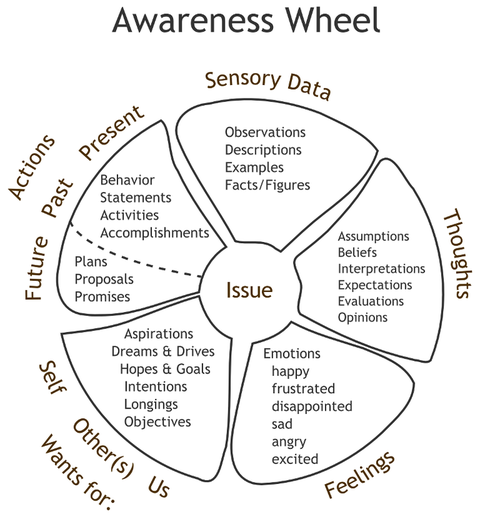
Communication using the Awareness Wheel
For years, researchers have studied what effective communication looks like in effective relationships between couples, parents/children, friends, and co-workers. Sherod and Phyllis Miller created a model consisting of The Awareness Wheel and Listening Cycle designed to improve communications in all kinds of relationships. Here is a quick overview of the process:
Rules for the both of you:
The Awareness Wheel Diagram was developed by:
Miller, Sherod, Phyllis Miller, Elam W. Nunnally, and Daniel B. Wackman. Talking and Listening Together: Couple Communication I. Littleton, Colo.: Interpersonal Communication Programs, 1991. Print.
Awareness Wheel: The Speaker defines the issues and then moves around the wheel covering:
The sensory data (how they know there is an issue--what they have observed, examples of when the issue happened, full description of the issue, facts, etc.)
When speaking, talk through your Awareness wheel using the first person, "I" statements.
Your thoughts (meanings you make out of the sensory data you receive - eg. beliefs, interpretations, expectations out of which you've created assumptions, benefits, conclusions, guesses, reasons, impressions, judgments, etc.)
Your feelings (your emotional responses to your thoughts, situations, sensory data, and your needs or wants.) If thoughts become difficult to identify, go to the feeling words list for suggestions.
Your wants for yourself, the other, and the relationship. This is the part that is most often neglected in communication and if this part is not fulfilled, it negatively impacts the relationship.
The actions--past and present--that have been taking regarding the issue. Leave the future actions (which are the resolution to the issue) until both people have had a turn on the awareness wheel.
While the speaker is on the Awareness Wheel, the other person is doing the Listening Cycle. Click here to learn how the cycle works.
For years, researchers have studied what effective communication looks like in effective relationships between couples, parents/children, friends, and co-workers. Sherod and Phyllis Miller created a model consisting of The Awareness Wheel and Listening Cycle designed to improve communications in all kinds of relationships. Here is a quick overview of the process:
Rules for the both of you:
- The speaker has the floor. Don't cut off the speaker or finish his or her sentences.
- Share the floor (take turns)
- No problem solving
- Make "I" statements, Speak for yourself and avoid telling the other what they think or feel
- Share your feelings without putting down the other person
- Be specific and brief about your perceptions and feelings (2 - 3 sentences)
- Stop and allow your listener to tell you what they heard you say. If they didn't accurately head what you said, state what was not heard in a polite way.)
- Be open to letting what the other person says change you. You won't be able to listen effectively if you are in a protective emotional state like "Anger", "Fear" or "Panic". See the Feeling Words List
- Always start by stating the issue--which stays the same until it is resolved. Keep the focus paraphrase on what the speaker said, not a rebuttal. Wait until you are the speaker to give your thoughts.
- After the paraphrase, ask the speaker "Is that right?" or "Did I miss anything?"
The Awareness Wheel Diagram was developed by:
Miller, Sherod, Phyllis Miller, Elam W. Nunnally, and Daniel B. Wackman. Talking and Listening Together: Couple Communication I. Littleton, Colo.: Interpersonal Communication Programs, 1991. Print.
Awareness Wheel: The Speaker defines the issues and then moves around the wheel covering:
The sensory data (how they know there is an issue--what they have observed, examples of when the issue happened, full description of the issue, facts, etc.)
When speaking, talk through your Awareness wheel using the first person, "I" statements.
Your thoughts (meanings you make out of the sensory data you receive - eg. beliefs, interpretations, expectations out of which you've created assumptions, benefits, conclusions, guesses, reasons, impressions, judgments, etc.)
Your feelings (your emotional responses to your thoughts, situations, sensory data, and your needs or wants.) If thoughts become difficult to identify, go to the feeling words list for suggestions.
Your wants for yourself, the other, and the relationship. This is the part that is most often neglected in communication and if this part is not fulfilled, it negatively impacts the relationship.
The actions--past and present--that have been taking regarding the issue. Leave the future actions (which are the resolution to the issue) until both people have had a turn on the awareness wheel.
While the speaker is on the Awareness Wheel, the other person is doing the Listening Cycle. Click here to learn how the cycle works.
